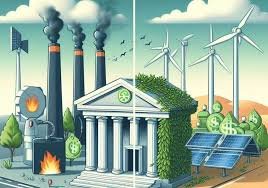The Growth of Green Finance: How Sustainable Investments are Shaping the Economy in 2024

1. The Emergence of Green Finance
Green finance, encompassing investments in environmentally sustainable projects and technologies, has gained significant traction in recent years. In 2024, green finance continues to grow, driven by increasing awareness of environmental issues and the need for sustainable economic development.
Sustainable Investment Vehicles: Green finance includes a variety of investment vehicles such as green bonds, sustainable mutual funds, and ESG (Environmental, Social, and Governance) funds. These instruments are designed to support projects that have positive environmental impacts, such as renewable energy, energy efficiency, and sustainable agriculture.
2. Key Drivers of Green Finance Growth
Several factors are contributing to the growth of green finance:
Regulatory Support: Governments and regulatory bodies are implementing policies to encourage green investments. For example, the European Union’s Green Deal and the U.S. Inflation Reduction Act provide incentives for investments in clean energy and sustainable infrastructure. These policies create a favorable environment for green finance and attract investors.
Increased Investor Demand: Investors are increasingly seeking opportunities that align with their values and support sustainability goals. The rise of impact investing and responsible investing reflects this trend, as investors prioritize environmental and social considerations alongside financial returns.
Corporate Commitments: Many companies are committing to sustainability goals and integrating environmental considerations into their business strategies. For instance, Microsoft and Apple have pledged to become carbon neutral by 2030, driving demand for green finance solutions to support their sustainability initiatives.
3. The Impact on the Economy
The growth of green finance is having a significant impact on the global economy, influencing various sectors and driving sustainable development.
Renewable Energy Investments: Green finance is fueling investments in renewable energy projects, such as wind and solar power. These investments contribute to reducing greenhouse gas emissions and transitioning to a low-carbon economy. According to the International Renewable Energy Agency (IRENA), renewable energy capacity is expected to continue growing, supported by green finance.
Sustainable Infrastructure Development: Green finance is also supporting the development of sustainable infrastructure, including green buildings, public transportation systems, and water management projects. These investments enhance urban resilience and contribute to long-term economic sustainability.
4. Challenges and Opportunities
While green finance offers numerous benefits, it also faces challenges that need to be addressed:
Lack of Standardization: The green finance sector lacks standardized definitions and criteria for what constitutes a green investment. This can lead to confusion and “greenwashing,” where investments are marketed as environmentally friendly without meeting rigorous standards. Efforts are underway to establish clearer guidelines and certification processes.
Access to Capital: Small and medium-sized enterprises (SMEs) and projects in developing countries may face challenges accessing green finance. Expanding access to capital and providing support for underserved regions will be crucial for achieving global sustainability goals.
Conclusion
The growth of green finance is shaping the economy by driving investments in sustainable projects and supporting environmental goals. With increasing regulatory support, investor demand, and corporate commitments, green finance is poised to play a pivotal role in the transition to a sustainable economy. Addressing challenges such as standardization and access to capital will be essential for maximizing the impact of green finance and advancing global sustainability efforts.







